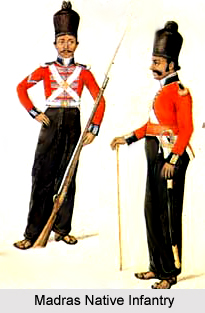 The 4th Madras Native Infantry was mainly an infantry regiment of the British East India Company. The unit was a part of the Madras Native Infantry under the Army of the Madras province, before the commencement of the Great Revolt of 1857. It served from the year 1758 to 1922. The Madras Army was the armed forces of Madras Presidency and one of the 3 major Presidency Armies in British India. The Army of Madras Presidency was established with the purpose of protecting the commercial interests of the British East India Company. The British Presidency Armies were a part of the British East India Company until the Indian Rebellion, also known as the Sepoy Mutiny of 1857. Later in the year 1903, the three main presidency armies were amalgamated to form the United British Indian Army. The army unit was also incorporated as a part of the Madras Command. The 4th Madras Native Infantry was also known as the 64th Pioneers regiment.
The 4th Madras Native Infantry was mainly an infantry regiment of the British East India Company. The unit was a part of the Madras Native Infantry under the Army of the Madras province, before the commencement of the Great Revolt of 1857. It served from the year 1758 to 1922. The Madras Army was the armed forces of Madras Presidency and one of the 3 major Presidency Armies in British India. The Army of Madras Presidency was established with the purpose of protecting the commercial interests of the British East India Company. The British Presidency Armies were a part of the British East India Company until the Indian Rebellion, also known as the Sepoy Mutiny of 1857. Later in the year 1903, the three main presidency armies were amalgamated to form the United British Indian Army. The army unit was also incorporated as a part of the Madras Command. The 4th Madras Native Infantry was also known as the 64th Pioneers regiment.
History of 4th Madras Native Infantry
The 4th Madras Native Infantry was raised as the 5th Battalion Coast Sepoys in the year 1758 by the Honourable British India Company. The military battalion was renamed a number of times through out its service. The regiment was designated as the 5th Carnatic Battalion in 1769 and was titled as the 4th Madras Battalion in the year 1784. In the year 1903, the regiment of Madras Native Infantry was designated for the last time as the 64th Pioneers regiment, when the titles of the British Indian presidencies were omitted after the Kitchener reforms of the British Indian Army.
Operations of 4th Madras Native Infantry
The 4th Madras Native Infantry took part in the Carnatic Wars from the year 1746 to 1763. Later the army unit fought in the Second Anglo Mysore War and the battle of Sholinghur. The unit also participated in the Second Anglo Maratha War, the battle of Assaye and the Second Afghan War. The regiment was also served during the Third Anglo Mysore War and the Boxer Rebellion. During the Great Revolt of 1857, 64th Pioneers regiment remained loyal to the British East India Company and did not participate in the rebellion. It served in the Central India Campaign during the Sepoy Mutiny. Later the regiment also provided military service during the First World War. The army unit was in the Mandalay Brigade in the Burma Division.
Dissolution of 4th Madras Native Infantry
After the end of World War I, the British Government of India re-structured and renumbered the regiments of the British Indian army. The different single battalion infantry regiments were combined together in order to form multi battalion regiments. As a result of such reforms, the battalion was renamed as the 2nd Battalion, 3rd Madras Pioneers in the year 1922. The 64th Pioneers regiment became a part of the Corps of Madras Pioneers in 1929. Eventually the unit was finally dissolved in the year 1933 for financial reasons.
Designations of 4th Madras Native Infantry
The 4th Madras Native Infantry regiment of the British Indian Army held several designations through out its existence. These are listed as follows -
* 5th Carnatic Battalion (1769 to 1770)
* 4th Carnatic Battalion (1770 to 1784)
* 4th Madras Battalion (1784 to 1796)
* 1st Battalion, 4th Madras Native Infantry (1796 to 1824)
* 4th Madras Native Infantry (1824 to 1883)
* 4th Madras Native Infantry (Pioneers) (1883 to 1901)
* 4th Madras Infantry (Pioneers) (1901 to 1903)
* 64th Pioneers



















